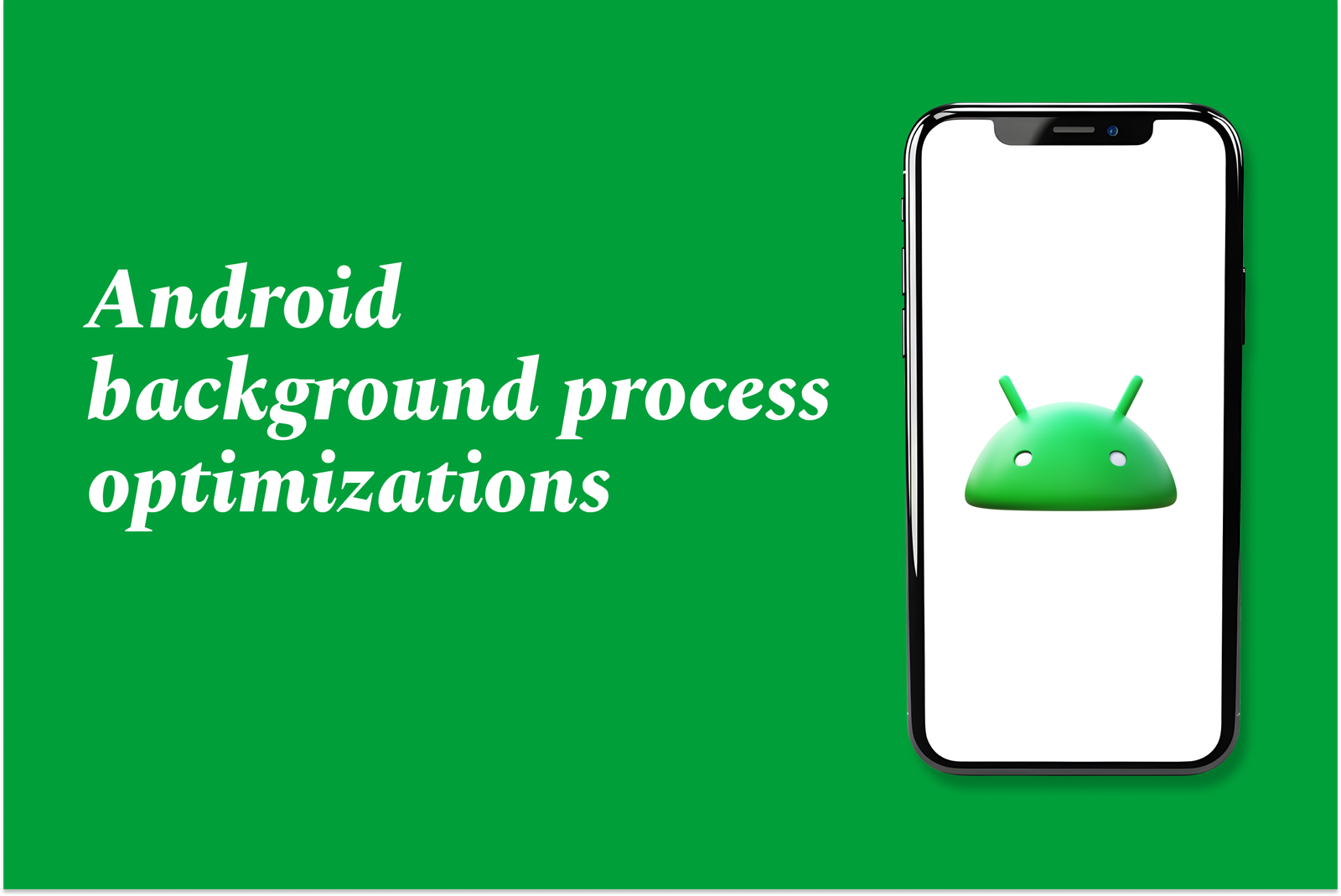Android Background Process Optimizations
Android background process optimizations involve managing apps’ background tasks efficiently to save battery and improve performance. They use system tools like WorkManager and Foreground Services while adapting to OS limits and device-specific battery restrictions for smooth, reliable operation.
Android background process optimizations
1 ) Introduction
Background services play a critical role in mobile apps for continuous operations like location tracking and notifications. However, newer mobile OS versions enforce stricter battery optimization and privacy policies, making background process management challenging. This article explains how to handle these constraints efficiently, especially with Android 14 and other platforms.
2 ) Why Optimize Background Processes?
Mobile operating systems prioritize extending battery life and enhancing security. Android 14 and iOS 17 introduce new restrictions that limit background activities to prevent excessive power consumption. Without optimization, apps risk forced termination, poor background execution, and diminished user experience.
3 ) Android 14 Background Services and Battery Optimization
Android 14 limits background and foreground service usage, requiring developers to adapt using system tools like WorkManager and JobScheduler.
Step 1: Use WorkManager for periodic background tasks with constraints like avoiding execution on low battery.
Step 2: Use Foreground Services with persistent notifications when critical background tasks are needed, but avoid excessive foreground servicing which is restricted.
Native integration may be necessary to implement these efficiently with React Native apps.
4 ) Device Manufacturer Battery Optimization Settings
Different Android device manufacturers implement aggressive background app restrictions. To ensure optimal background processing, apps should be excluded from battery optimization on popular devices:
Samsung Devices:
For Android 11 & 12, disable battery optimization for the app in Settings > Apps > Battery.
Disable features like “Auto optimize daily” and “Put unused apps to sleep” under Battery and device care settings.
Xiaomi Devices:
On Android 10+, disable battery optimization by selecting “No restrictions” for the app in Settings > Apps > Manage Apps > Battery Saver.
OnePlus Devices:
On Android 11+, turn off battery optimization for the app under Battery settings and Apps & notifications > Special app access.
Disable advanced battery saving features such as Deep optimization and Sleep standby optimization.
Oppo Devices:
Adjust power saving settings on Android 11 to prevent the system from restricting apps reliant on background processes.
5 ) Best Practices for Background Services
Use Android system managed APIs (WorkManager, JobScheduler) which work within OS constraints.
Provide clear user notifications when running foreground services to align with new platform rules.
Test on various device manufacturers to handle custom battery optimizations.
Educate users on excluding the app from battery optimization or sleep restrictions to ensure reliable background operation.
6 ) Conclusion
Effective background process optimization is essential in the current mobile OS landscape to maintain app performance and battery efficiency. Developers should leverage platform tools, respect OS constraints, and configure device specific battery settings carefully to enable smooth background operations.
https://justacademy.in/news-detail/latest-android-camera-app-innovations
https://justacademy.in/news-detail/android-app-developer-conference-highlights
https://justacademy.in/news-detail/android-accessibility-tool-advancements
https://justacademy.in/news-detail/upcoming-android-features-announced-by-google
https://justacademy.in/news-detail/dartconf-2025-highlights
Related Posts
Java supports GDPR and data privacy by enabling secure data handling through encryption, controlled access, and precise data management. It allows developers to minimize PII exposure, ensure data confidentiality, and design workflows that comply with data protection regulations effectively.
Java code quality tools have evolved to include advanced static analysis, integrated security checks, and AI-powered code reviews. These updates help developers detect bugs, enforce coding standards, and enhance security, streamlining the development process and improving overall code reliability.
Java remains a cornerstone in big tech companies, evolving with modern features like records, pattern matching, and virtual threads. Its robust ecosystem, enhanced performance, and growing AI integrations keep it vital for both legacy systems and innovative new projects.
Java and CI/CD pipeline optimizations streamline Java application development by automating builds, tests, and deployments. They improve efficiency through parallelization, caching, and secure secrets management, enabling faster feedback loops and more reliable, scalable software delivery.
Java supports modern cryptography standards through its flexible Java Cryptography Architecture (JCA), enabling integration of advanced algorithms like AES, EdDSA, and post-quantum tools. Libraries like Bouncy Castle offer FIPS-certified, hardware-accelerated implementations for secure development.
Java 23 enhances record patterns by enabling concise, direct destructuring of record components within pattern matching, simplifying type checks and data extraction. This improvement boosts code readability and expressiveness by reducing boilerplate in handling immutable data classes.
Java remains a top choice for mobile app backends, powering scalable, secure, and high-performance server-side solutions. Latest trends include cloud-native microservices, reactive programming, and enhanced JVM optimizations, enabling efficient, flexible, and robust mobile backend development.
Java SE 24 and LTS Java SE 21 offer enhanced features and performance, while Apache Spark 4.0.0 introduces Scala 2.13 support and advanced ML and SQL capabilities. Together, they empower developers to build scalable, high-performance data applications with modern tools.
JUnit 5 modernizes Java testing with a modular architecture, improved assertions, and seamless Java 8+ support. Beyond JUnit, tools like Mockito and AssertJ enhance mocking and assertions, creating a powerful, flexible ecosystem for writing clean, efficient Java unit tests.
Java plays a pivotal role in cloud automation tools by providing a robust, platform-independent language used to build scalable automation frameworks like Jenkins and Selenium, enabling efficient CI/CD pipelines, testing, and orchestration across diverse cloud environments.










